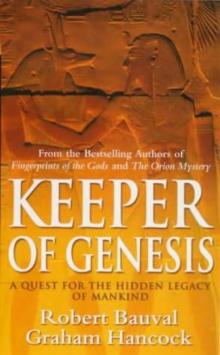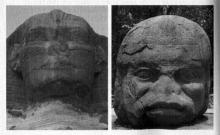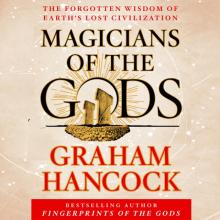- Home
- Graham Hancock
The Message of the Sphinx AKA Keeper of Genesis Page 8
The Message of the Sphinx AKA Keeper of Genesis Read online
Page 8
Details of these alignments have already been given in Chapter 3. It is therefore sufficient here to remind ourselves that the Great Pyramid stands at a point on the earth’s surface exactly one third of the way between the equator and the north pole (i.e. astride latitude 30) and that its ‘meridional’ (i.e. north-south) axis is aligned to within three-sixtieths of a single degree of true north-south. It is a small but significant point that this alignment is more accurate than that of the Meridian Building at the Greenwich Observatory in London—which is offset by an error of nine-sixtieths of a degree. In our opinion, such precision constitutes a ‘fact’ which archaeologists and Egyptologists have never seriously considered, i.e. that the Great Pyramid, with its 13-acre footprint and six million tons of mass, could only have been surveyed and set out by master astronomers.[112]
16. The trajectory of the sun on the summer solstice, with its culmination point (highest altitude) being attained at meridian transit.
17. The trajectory of the sun on the equinox.
18. The trajectory of the sun on the winter solstice.
It is our conviction that this ‘astronomical factor’ deserves to be given much greater prominence than it has hitherto been accorded by Egyptologists. Moreover, thanks to the recent development of sophisticated star-mapping computer programs, it is possible for us to simulate the skies over Giza in any epoch during the past 30,000 years and thus to recreate the celestial environment in which the Pyramid builders worked.
Standing as it were beneath those ancient skies, initiated by microchip into the cosmic secret of the changing positions of the stars, certain features of the key monuments—features that are of no significance from the purely archaeological or Egyptological perspective—begin to take on a peculiar meaning.
Targeting Stars
Let us begin with the four mysterious shafts emanating from the King’s and Queen’s Chambers of the Great Pyramid, the engineering aspects of which we considered at the end of the previous chapter. As we have seen, two of these shafts are aligned perfectly to due north and the other two perfectly to due south. They thus target, at varying altitudes, what astronomers refer to as the ‘meridian’—an imaginary line ‘dividing the sky’ that is best envisaged as a hoop connecting the north and south poles and passing directly over the observer’s head. It is as they cross this imaginary line (‘transit the meridian’) that the stars (and also the sun, moon and planets) are said to ‘culminate’—that is, reach their maximum altitude above the horizon.
19. The horizon of Giza and the meridian of the Great Pyramid.
20. Culmination (meridian-transit) of Orion’s belt circa 2500 bc. In this epoch the belt stars crossed the meridian at altitude 45 degrees, targeted by the southern shaft of the King’s Chamber.
21. For the ancient Egyptians the constellation of Orion, and particularly its three prominent belt stars, were strongly associated with Osiris, the god of resurrection and rebirth.
22. The stellar alignments of the Great Pyramid’s four shafts in the epoch of 2500 bc.
The Great Pyramid has numerous features which leave us without any doubt that its designers paid careful attention to the stars and tracked their transit at the meridian. The mouth of the original entrance corridor, for example, targets the meridian with the precision of the barrel of an artillery piece. All the internal passageways, too, run perfectly north-south, thus making the whole monument, as many astronomers have noted, an obvious ‘meridional instrument’.[113] Most conclusive of all, however, is the fine accuracy of the four shafts. Recent investigations have established beyond any shadow of doubt that in circa 2500 bc—the era recognized by Egyptologists as the ‘Pyramid Age’—each one of these shafts targeted a special star as it culminated at the meridian:
From the Queen’s Chamber, the northern shaft is angled at 39 degrees and was aimed at the star Kochab (Beta Ursa Minor) in the constellation of the Little Bear—a star associated by the ancients with ‘cosmic regeneration’ and the immortality of the soul. The southern shaft, on the other hand, which is angled at 39 degrees 30’, was aimed at the bright star Sirius (Alpha Canis Major) in the constellation of the Great Dog. This star the ancients associated with the goddess Isis, cosmic mother of the kings of Egypt.[114]
From the King’s Chamber, the northern shaft is angled at 32 degrees 28’ and was aimed at the ancient Pole star, Thuban (Alpha Draconis) in the constellation of the Dragon—associated by the Pharaohs with notions of ‘cosmic pregnancy and gestation’. The southern shaft, which is angled at 45 degrees 14’, was aimed at Al Nitak (Zeta Orionis), the brightest (and also the lowest) of the three stars of Orion’s belt—which the ancient Egyptians identified with Osiris, their high god of resurrection and rebirth and the legendary bringer of civilization to the Nile Valley in a remote epoch referred to as Zep Tepi, the ‘First Time’.[115]
Because we can reconstruct the ancient skies over Giza with modern computers we can demonstrate the spot-on alignments of the four shafts to the four stars circa 2500 bc. What the same computers also show us is that these alignments were rare and fleeting, only valid for a century or so, before the continuous gradual change effected in stellar altitudes by the passage of time altered the positions at which the stars transited the meridian.
This phenomenon, the result of a slow and stately wobble in the axis of the earth, is known technically as precession. Over a cycle of 25,920 years it causes the infinitely-extended north pole of our planet’s spin axis to trace out a great circle in the heavens. The main astronomical effects of this motion are:
1. an equally slow and stately change in the celestial north pole—which sometimes coincides with a ‘pole star’ (and sometimes with empty space) as it progresses eternally around its 25,920-year cycle;
2. changes in the altitude of all stars above the horizon as they cross the observer’s meridian at any given latitude;
3. changes in the constellations against the background of which the sun rises due east at dawn on the spring equinox (naturally precession also changes the constellations that mark the autumnal equinox—and the winter and summer solstices as well).
The rate of precessional change is constant and predictable for each of these key astronomical effects and can be calculated backwards and forwards in time across the entire star-field. This means, for example, that if we were to observe a specific bright star—say Al Nitak in Orion’s belt—from a given place today, and if we were to record its altitude at the meridian, then provided such a record was to be found and understood thousands of years hence it could be used to determine the epoch or ‘time’ when the original observation was made.
The same logic can be applied to the four meridional shafts emanating from the King’s and Queen’s Chambers. Their alignments at 2500 bc—on four stars that were of ritual importance within the ‘Osiris cycle’ of beliefs—cannot possibly have been accidental. On the contrary, it is obvious that we are confronted here by the products of a conscious and careful design. This in turn makes it equally obvious that the Great Pyramid must have some extremely strong connection with the epoch of 2500 bc—the approximate date at which all orthodox Egyptologists and archaeologists in fact believe it to have been built.
In short, the four star-shafts serve as precise time-markers by which, in theory at least, we should be able once and for all to confirm the date for the construction of the last-surviving wonder of the ancient world. This would be highly desirable since, in the absence of other objective means of dating the monument, controversy continues to linger over its exact age. However, the archaeoastronomical picture is rather more complicated than it seems.
The Companions of Osiris
The complication arises from the strong correlation, first demonstrated in The Orion Mystery, between the three belt stars of the Orion constellation and the ground-plan of the three Pyramids of Giza. An overhead view shows that the Great Pyramid and the second Pyramid stretch out along a diagonal running 45 degrees to the south and west of the former�
�s eastern face. The third Pyramid, however, is offset somewhat to the east of this line. The resulting pattern mimics the sky where the three stars of Orion’s belt also stretch out along a ‘faulty’ diagonal. The first two stars (AI Nitak and Al Nilam) are in direct alignment, like the first and second Pyramids, and the third star (Mintaka) lies offset somewhat to the east of the axis formed by the other two.[116]
The visual correlation, once observed, is obvious and striking on its own. Additional confirmation of its symbolic significance, however, is provided by the Milky Way, which the ancient Egyptians regarded as a kind of ‘Celestial Nile’ and which was spoken of in archaic funerary texts as the ‘Winding Waterway’.[117] In the heavenly vault the belt stars of Orion lie to the west of the Milky Way, as though overlooking its banks; on the ground the Pyramids stand perched above the west bank of the Nile.[118]
Faced by such symmetry, and by such a complex pattern of interlocking architectural and religious ideas, it is hard to resist the conclusion that the Pyramids of Giza represent a successful attempt to build Orion’s belt on the ground. This makes all the more sense when we recall the firm identification of the Orion constellation with the high god Osiris.
But bearing in mind the changes induced by the phenomenon of precession we must also ask: ‘Orion’s belt when?’ ‘Orion’s belt in what epoch?’
A perfect match
From the evidence of the shafts we have seen how the Great Pyramid is ‘precessionally anchored’ to Orion’s belt in 2500 bc (because in this epoch the southern shaft of the King’s Chamber targeted the meridian-transit of Al Nitak, the Great Pyramid’s celestial counterpart). If we set our precessional computer to reconstruct the ancient skies over Giza, however, turn our attention to the pattern formed on the ground by all three of the Pyramids in 2500 bc, simulate the nightly passage of the belt stars across the roof of the celestial sphere and bring them to rest at the point of Al Nitak’s meridian-transit (45 degrees above the southern horizon, where it is targeted by the King’s Chamber shaft), it becomes apparent that something is not quite right.
23. Orion’s belt crossing the meridian of the Great Pyramid in 2500 bc with the star Al Nitak, the Great Pyramid’s celestial counterpart, in perfect alignment with the southern shaft of the King’s Chamber at an altitude of 45 degrees. However, note how the belt stars and the Milky Way appear out of kilter and askew in relation to the ground plan of the three Pyramids and the Nile. The sky-ground images are, of course, similar, but there is a sense that the sky image needs somehow to be ‘twisted’ in an anti-clockwise direction to get the perfect match. This can only be achieved by going back in time—by looking at the sky above Giza in a far earlier epoch ...
24. The perfect match of sky-ground images is achieved in 10,500 bc when the pattern of the Milky Way and of the three stars of Orion’s belt at meridian transit is precisely matched by the course of the Nile and the pattern of the three great Pyramids on the ground.
We should expect to see a perfect meridian-to-meridian alignment at this point. Instead we notice that the dominant axis of the three stars and the Milky Way lies tilted conspicuously askew relative to the dominant axis of the three Pyramids and the Nile. These latter, of course, are fixed in their places. What is required, therefore, in order to achieve the ‘ideal’ sky-ground arrangement, is somehow to ‘rotate’ the heavens in an anticlockwise direction.
The vast cosmic engine of the earth’s axial wobble offers us a mechanism by which this can be done: we need only instruct our computer to track the precessionally induced movements of the stars backwards in time.
As it does so, millennium by millennium, we observe that the orientation of Orion’s belt at culmination is slowly rotating anti-clockwise and thus approaching ever closer to our desired meridian-to-meridian match. It is not until 10,500 bc, however—8000 years before the ‘Pyramid Age’—that the perfect correlation is finally achieved with the Nile mirroring the Milky Way and with the three Pyramids and the belt stars identically disposed in relation to the meridian.[119]
Rising stars
There is a feature of this 10,500 bc correlation which suggests strongly that coincidence is not involved. The pattern that is frozen into monumental architecture in the form of the Pyramids marks a very significant moment in the 25,920-year precessional cycle of the three stars of Orion’s belt—one that is unlikely to have been randomly selected by the Pyramid builders.
To get a clear grasp of what is involved here let us call up a computer simulation of the skies over Giza in our own epoch, circa ad 2000. Looking due south we note that Al Nitak crosses the meridian at an altitude of 58 degrees 06’ above the horizon. This, as it happens, is within 8 minutes of the highest altitude that this star will attain in its precessional cycle, i.e. 58 degrees 14’ (to be reached at around ad 2500).[120]
Let us now project our simulation backwards in time and recreate the sky as we would see it if we were standing in the same position at around 10,500 bc—i.e. just under 13,000 years, or half a precessional cycle, earlier. In this remote epoch we discover that Al Nitak crosses the meridian at an altitude of only 9 degrees 20’ above the horizon.[121]
25. By mimicking the sky pattern of Orion’s belt in 10,500 bc the three great Pyramids of Giza mark a very significant moment in the 20,000-year precessional cycle of these stars—the lowest point in their slide up and down the meridian, when (as seen from the latitude of Giza) they culminated at an altitude of 9 degrees 20 minutes above the horizon (C). In 2500 bc they culminated at altitude 45 degrees (B). In our own epoch, 2000 ad (A) they are approaching the highest altitude that they will attain in their precessional cycle—58 degrees 06 minutes above the horizon at meridian transit.
It will never fall lower, the epoch of 10,500 bc marks the nadir of the star’s precessionally induced slide up and down the meridian (just as the epoch of AD 2500 marks its zenith). Like a slowly moving lever in a narrow vertical slot, it takes 12,960 years to descend from top to bottom, and a further 12,960 years to ascend from bottom to top again.[122]
By exactly mimicking the disposition of the belt stars in the sky in 10,500 bc the layout of the Pyramids on the ground thus not only signifies a specific epoch but also rather precisely and surgically marks the beginning of a precessional half-cycle.
Lion on the ground, lion in the sky
As was pointed out in Fingerprints, of the Gods, the same role is played by the Great Sphinx—which gazes directly at the equinoctial rising point of the sun in any and every epoch, past, present and future, for ever.
26. Artist’s impression showing the precessional cycle of Orion’s belt up and down the meridian. The pattern of the stars in 10,500 bc marks the beginning, or ‘First Time’, of the cycle. It is this pattern that is reproduced on the ground by the three great Pyramids of Giza.
27. The rising points and trajectory of Orion’s belt in (A) 2000 ad, (B) 2500 bc, (C) 10,500 bc.
This orientation provides us with an astronomical basis for dating the monument because it is known that the attention of astronomers in ancient times was particularly focused on the zodiacal constellation—considered to define the astrological ‘Age’—that rose just ahead of the sun in the eastern sky at dawn on the spring equinox.[123] The same phenomenon of the earth’s axial precession that affects the altitude of stars at the meridian also affects these famous constellations—Leo, Cancer, Gemini, Taurus, Aries, Pisces, Aquarius, etc., etc—the co-ordinates of which, in relation to the rising point of the equinoctial sun, undergo slow but continuous precessionally induced changes. The result is a hard-to-observe astronomical phenomenon, known as the precession of the equinoxes, which manifests as a gradual circulation of the equinoctial point around all twelve ‘houses’ of the zodiac. In the words of historians of science Giorgio de Santillana and Hertha von Dechend, whose essay Hamlet’s Mill is a ground-breaking study of archaic precessional mythology:
The constellation that rose in the east just before the sun (that is, rose heliacally) marke
d the ‘place’ where the sun rested ... It was known as the sun’s ‘carrier’, and as the main ‘pillar’ of the sky. ... The sun’s position among the constellations at the vernal [spring] equinox was the pointer that indicated the ‘hours’ of the precessional cycle—very long hours indeed, the equinoctial sun occupying each zodiacal constellation for just under 2200 years.[124]
In our own epoch the sun on the spring equinox rises against the stellar background of the constellation of Pisces, as it has done for approximately the last 2000 years. The ‘Age of Pisces’, however, is now approaching its end and the vernal sun will soon pass out of the sector of the Fishes and begin to rise against the new background of Aquarius. To be precise, it takes exactly 2160 years for the equinoctial point to pass completely through one constellation or ‘house’ of the zodiac.

 Underworld: The Mysterious Origins of Civilization
Underworld: The Mysterious Origins of Civilization The Master Game: Unmasking the Secret Rulers of the World
The Master Game: Unmasking the Secret Rulers of the World America Before
America Before Entangled
Entangled War God: Nights of the Witch
War God: Nights of the Witch War God: Return of the Plumed Serpent
War God: Return of the Plumed Serpent The Message of the Sphinx AKA Keeper of Genesis
The Message of the Sphinx AKA Keeper of Genesis Fingerprints of the Gods
Fingerprints of the Gods The Sign and the Seal
The Sign and the Seal The Mars Mystery: The Secret Connection Between Earth and the Red Planet
The Mars Mystery: The Secret Connection Between Earth and the Red Planet Magicians of the Gods: The Forgotten Wisdom of Earth's Lost Civilization
Magicians of the Gods: The Forgotten Wisdom of Earth's Lost Civilization War God
War God Underworld
Underworld The Mars Mystery
The Mars Mystery Magicians of the Gods
Magicians of the Gods The Master Game
The Master Game